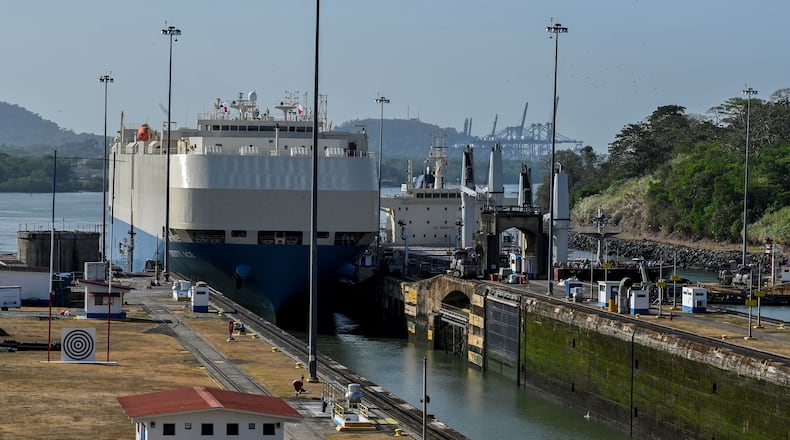SAVANNAH — Heading to and from the Georgia Ports Authority’s bustling terminals, most container ships pass through one of two gateways: The Panama Canal in Central America or the Suez Canal in Egypt.
But both canals — vital passageways for global trade — are seeing significant disruptions to travel: Panama because of drought and the Suez due to rocket-firing militants backed by Iran. The leader of the nation’s third-busiest container port voiced concerns about a slowdown but is uncertain about when the Savannah facilities will start to feel the effects and to what extent.
Fears of trade disruption come as the Port Authority’s Garden City and Ocean terminals, located along the Savannah River west of downtown Savannah, are experiencing a “strengthening” market. Ports Authority President and CEO Griff Lynch told the authority’s board of directors Tuesday that trends are positive year-over-year “not withstanding” the canal challenges, and a port spokesman said container volumes are up in January.
“It could impact us but (we) should see some good months ahead,” Lynch said.
Container volumes were down 4% year-over-year in December but remain 17% ahead of pre-COVID-19 levels, a benchmark used by the Ports Authority. The pandemic closed manufacturing facilities across the world for much of 2020, tanking volumes that year. A spike in shipping to meet pent-up demand followed in 2021 and 2022. Volume leveled off for much of 2023.
About 78% of the container cargo handled by the Savannah terminals moves between the United States and Asia via one of the canals. Overall, 46% of East Coast container traffic passes through Panama and 18% via the Suez.
Panama’s driest dry season
The Panama Canal is a 50-mile-long link between the Atlantic and Pacific oceans and saves shippers about 8,000 miles of travel. The canal operates via locks that pump 50 million gallons of freshwater from nearby lakes and reservoirs to move each ship through the passage, and a severe drought has prompted authorities to limit traffic through the duration of the country’s dry season, which runs from January through May.
The cutback means 24 ships, down from 38, will be permitted to access the canal daily. The move is sure to increase wait times, which currently is 10 to 11 days for Pacific-to-Atlantic passage and four to five days for Atlantic-to-Pacific bound vessels. Most of the vessels facing delays currently are tankers and not container ships, accounting for the sustained business in Savannah.
Still, the situation has already prompted one shipper, Maersk, to announce plans to lighten heavily laden vessels for canal passage by offloading some cargo and moving it across Panama via rail, where it is then reloaded onto the ship. There’s speculation among industry analysts that others could reroute East Coast-bound ships to West Coast ports and move some cargo across the U.S. on trains, although the Ports Authority’s Lynch said that approach has significant limitations.
“You run the risk of overwhelming the rail,” Lynch said. “As we learned about the supply chain during the pandemic, The resiliency is not there. If you shift a whole bunch of business to one place, all at once, you overwhelm it and you blow it up.”
Credit: TNS
Credit: TNS
Trouble near the Suez
As for the Suez Canal, the 120-mile-long waterway eliminates the need for ships to sail around the southern tip of Africa en route to Europe or North America .
The Suez links the Atlantic and Indian oceans through the Mediterranean Sea to the west and the Red Sea to the east. Yemen-based Houthi militants have laid siege to the 18-mile-wide straight where the Red Sea meets the Indian Ocean, known as the Bab el-Mandeb or “Gate of Tears,” in protest of Israel’s military action against Hamas in Gaza.
The U.S. military, along with United Kingdom forces, have moved to protect ships in the area in recent weeks. However, cargo traffic through the Suez is down 40% compared to a year ago, according to IMF PortWatch.
Many shippers are opting instead to take the 5,500-mile detour south around South Africa’s Cape of Good Hope, adding 10 days to the journey.
Savannah’s port terminals have become more popular with Suez-transiting ships in recent years as manufacturers have diversified their operations beyond China and opened new facilities in India, Vietnam and other locales. Moving goods west through the Suez instead of east through Panama is more efficient from those geographic points to the East Coast.
The rise in Suez traffic through Savannah in recent years — from 780,000 container equivalent units in 2019 to nearly 1.1 million in 2023 — is the main reason why the Ports Authority has petitioned Congress to authorize a study into a further round of deepening the Savannah River shipping channel. The Suez Canal is wider than the Panama Canal, and shippers utilize larger and deeper drafting ships for Suez-bound cargo.
The Savannah River depth is 47 feet and not deep enough to accommodate those bigger ships at all tides.
Auto hub
The Ports Authority’s terminals in Brunswick closed 2023 with record volumes for roll-on, roll-off cargo, handling 775,565 units of autos and wheeled machinery. The business topped the previous best by 15.6%.
Brunswick is the second-busiest port for autos in the nation behind Baltimore and is on pace to claim the No. 1 spot in 2026.
About the Author
Keep Reading
The Latest
Featured





